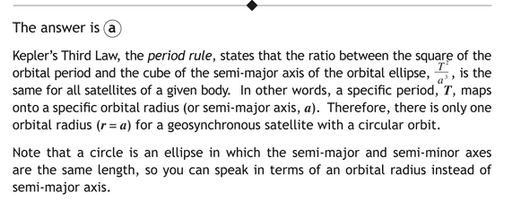From Newton's Universal law of Gravitation: G*M*m/r^2=F=m*a
Where G is gravitational constant (~6.67*10^-11 N*m^2/kg) M is mass of the larger body (usually Earth for MCAT), m is the mass of the object that is being "attracted" to the larger one, r is the distance between the center of masses of the two objects (r is from the fact that is a radius) and a is the acceleration
Since the object is in circular rotation a=v^2/r (from circular motion fomulae)
G*M*m/r^2=m*v^2/r
m's cancel and 1 r term cancels to get:
G*M/r=v^2
B is incorrect because a higher orbit means the masses are further apart (i.e. r gets larger) and according to the above equation and increase in r would make v^2 (or the speed) smaller. The problem with your reasoning is that you (mistakenly) are assuming that the time it takes to orbit (the period {T}) remains constant for all orbiting bodies. You may be thinking of this like a record player where the tangential velocity (v) is greater on the edges than in the middle, but the angular velocity (omega) is constant. This isn't the case here because mass attraction (gravity) is what is pulling the satellite to the Earth and gravity isn't constant at all distances (in fact it is inversely proportional to the square of the distance {i.e. 1/r^2}). As you move further out the force of gravity decreases.
A is correct because the distance from the center of a circle to the edge is the same (i.e. you only have one value for the radius). This question is trying to get you to understand that for elliptical orbits the distance isn't going to be the same from the center which is why on elliptical orbits the speed is greater when the object gets close to the planet the velocity is high (again gravity is pulling it in).




